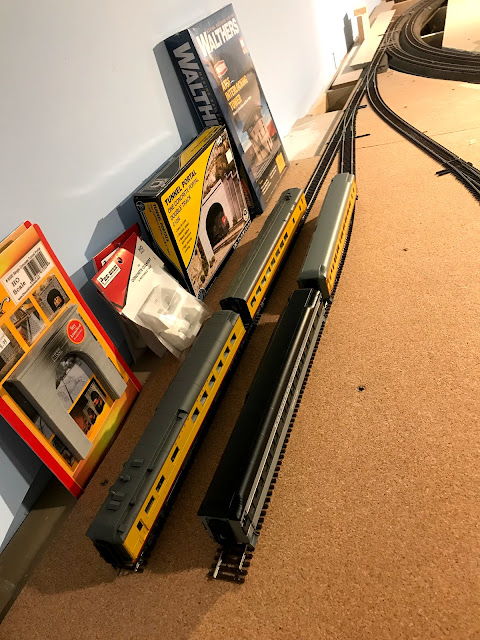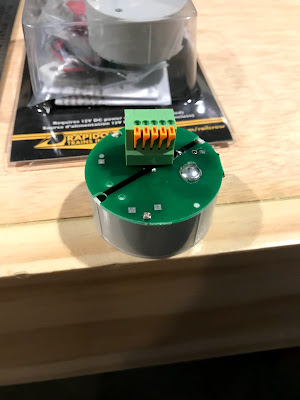In early July I attended the NMRA National Convention here in Salt Lake City, during which I attended every clinic I could. Doing this created long days, starting at 7 am and ending after 10, but it was a great learning experience. So many tips on modeling and operations were shared, along with many ideas for the layout. The instructors and clinics were all first rate, but the population of attendees tended to be annoying (a whole post could be written on that), leading me to focus more on my hobby than the larger community in which it exists.
After the NMRA Convention I took a much-needed break from the layout and the hobby to get in some travel (including trips to Italy, France, California, New York and Washington DC) and focus on things that had been neglected. This blog, along with my layout, have been on hold for the summer while I was taking a break from the hobby. Like the 'TV people' in Poltergeist I'm baaaaack.
Back at work slowly on the the layout, the first activity was to have an actual Operating Session. Focused on the terminal, the ops session put its construction and actual operation to the test. The session was a success: the prototype-based switching and car flow went smoothly, and the operators really enjoyed it. The feedback was that, having never operated a passenger terminal before, it was really fun to work the scenarios as a team. Because a passenger terminal runs on a tight schedule and its switch moves occur on both ends of a live train, operators have to work carefully as a team to coordinate their moves. This teamwork tests crews in ways that typical freight operations do not. Following this operating session, the terminal is now expanding into some new operations.
Adding a Commissary
Passenger operations are interesting to model is so many ways. Mail and express operations, long forgotten as part of railroading, generated a major portion of activity at passenger stations - especially at major points on the mainline or a junctions serving multiple roads. But then there is the main equipment of the passenger trains themselves - the coaches, sleepers, dining cars, lounges. Each of these cars is carried on trains for generating revenue and is subject to the ebb and flow of passengers for their assignment to particular trains. Union Pacific's City of St. Louis, for example, typically added three westbound coaches and a 4000 Series lunch counter car in Denver starting in 1956 to handle tourist traffic to Las Vegas. During the busy summer months after 1957, UP's Challenger carried a Milwaukee Super Dome between Cheyenne and Ogden (Chicago to Los Angeles starting 1961). Mail trains added sleepers, coaches and dining cars for certain segments with peak passenger traffic. The point is that passenger consists rarely stayed intact for their entirely run, which was particularly the case for secondary trains, extras and additional sections.
As a freelanced transfer point serving multiple roads (SP, ATSF, UP), the Overland Terminal serviced dining cars, lounges, sleepers and an occasional coach. Modeling the operation took some research and planning, but the resulting facility ended up being fairly simple, as shown here:
 |
| Arial view of the Commissary tracks being laid and tested with typical dining cars and sleepers. |
Scaled down considerably from the original concept of a full coach yard operation, the limited space conveniently near the passenger terminal in the southeast corner of the layout forced narrowing the scope, design and operation to a commissary. Commissary-only operations were not uncommon on railroads. Ogden Depot is a case in point, having a major commissary for food service and laundry without the full coach yard of shops and related facilities. Here food service cars are set out just long enough to be cleaned and provisioned between runs, often for just a few hours, then are picked up by the next train. Sleepers terminating or originating in Monte Vista are serviced (cleaned, restocked with fresh linens, water,etc.) here as well.
Because the Commissary is a food service facility and laundry, it has to maintain fresh stock at all times. Not shown here but modeled will be the additional movements of reefers and box cars onto these tracks. Carrying fresh meats and produce from distant sources, express reefers were often assigned to passenger and mail trains exclusively for the purpose of provisioning the Commissary. This operation will be modeled here, requiring operators to identify and pull the correct express reefer(s) from incoming mail/express trains to spot at the Commissary.
Paring the operation down to just a commissary with two simple tracks might look like an egregious compromise, but it really provides clarity of purpose and better operation. This compromise could be an example of that over-used model railroaders' term 'selective compression.' Honestly, that term has always bugged me as a throwaway line to rationalize poor planning. It is quite simply selection, a choice on what to model and what is expendable. A layout, at the end of the day, is a space modeled. So much of the hard work of planning and building a layout is selecting what is important to model and using the remaining serviceable space to support its operation. In this case, a commissary operation is something that can be modeled and operated effectively without taking up a lot of space, just as the terminal was built.
With the capacity for four cars, the Commissary is deceptive in its apparent simplicity. The challenge facing this operation is pure car flow - the frequent turning of cars in and out for their trains. A westbound train could set out a diner, a sleeper or two, before leaving town. Its eastbound counterpart arriving in just 2 hours, will pick up these cars OR only the diner and a sleeper, the other sleeper getting reassigned to another train. Two trains could stop, each setting out a diner, lunch counter and/or a lounge car. For the operator, who likely will be shuttling these cars back and forth to the terminal in the next room, will have to keep on his toes with regard to time tables and turning cars quickly between multiple trains. Whether this role is assigned to one of the two station operators or a separate operator will depend on the schedule, crew availability or other factors, the beauty of it being that it can adapt to the variable needs of the ops sessions.
As both pictures make clear, this operation will have some ergonomic challenges too. Tucked away in the background behind the busy Keys Branch (which connects Monte Vista to the nearby yards feeding traffic to Los Angeles and points north and east), operators will have to pay attention to trains moving in the foreground as they switch their own trains. With the tracks potentially beyond arm's reach, and handling passenger cars with tight coupling and diaphragms, operators will struggle with uncoupling.
Magnets present a solution. Two types are available: permanent magnets and electro-magnets. Permanent magnets can be effective, but they are always on. Having used permanent magnets elsewhere, I found them to be too unreliable for my operation. Track imperfections, running too slow or any jerking in motive power uncouples trains. This is frustrating as hell! I've resorted to electro-magnets because they can be controlled by a swritch on the fascia. Once operators know their location, they can be turned on and off as needed. There's wiring and electronic involved, but all modeling choices have trade-offs. Given the restrictions of diaphragms and distance to uncoupling points, electro-magnets are the only realistic choice.
There are many choices on the market. For my purposes I chose RailCrew on-off remote uncoupler electro-magnets by Rapido Trains, Inc. Retailing for between $17-20 USD, RailCrew units are modular, fully-contained units. By drilling a 1 3/4" R hole under the track, these uncouplers can be hidden under the track and ballast, unlike other options that are plainly-visible above the ties. RailCrew units also have all the hook-ups built in for easier wiring. They come as complete kits with the wiring and switches for their operation.
There are many choices on the market. For my purposes I chose RailCrew on-off remote uncoupler electro-magnets by Rapido Trains, Inc. Retailing for between $17-20 USD, RailCrew units are modular, fully-contained units. By drilling a 1 3/4" R hole under the track, these uncouplers can be hidden under the track and ballast, unlike other options that are plainly-visible above the ties. RailCrew units also have all the hook-ups built in for easier wiring. They come as complete kits with the wiring and switches for their operation.
 |
| Add caption |
Building for Operations, Less is More
As I have learned from experienced operators, research and careful planning pay off quickly in the quality of the operation. In my case, I often start with a grandiose vision of some massive, sophisticated operation with all the bells and whistles one can imagine. Faced with the practical realities of actually building and operating it, however, forces immediate choices and compromises. In my case, these choices, or 'selections' as I called them earlier, always involve scaling it way back and throwing things out. The obvious reaction would be profound disappointment because I had to compromise what I really wanted in order to get what I have. But actually the opposite effect is what I've experienced. The more I focus, scale down, eliminate and simplify and operation, the greater my satisfaction in actually creating a good model that is fun to operate. Oscar Wilde wrote that sophistication is the fine art of the simple things.



Comments
Post a Comment